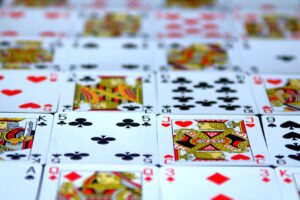“Mastering the Poker Deck: Unveiling the 52-Card Arsenal for Unstoppable Wins at the Poker Table” is a comprehensive guide that delves into the intricacies of poker and provides valuable insights on how to maximize your chances of winning. This article explores the 52-card deck, unraveling its secrets and equipping players with the knowledge and strategies needed to dominate the poker table. Whether you are a beginner looking to grasp the fundamentals or an experienced player seeking to enhance your skills, this book offers a wealth of information and techniques to help you achieve unstoppable wins in the thrilling game of poker.
The History and Evolution of the Poker Deck: From the Wild West to the Modern Poker Table
The origins of the poker deck can be traced back to the 9th century in China, where playing cards were first invented. These early cards were made of paper and featured suits such as coins, strings of coins, myriads, and tens of myriads. It wasn’t until the 14th century that playing cards made their way to Europe, where they quickly gained popularity.
In Europe, the suits of the cards were modified to reflect the culture and traditions of the region. The coins became diamonds, the strings of coins turned into clubs, the myriads transformed into spades, and the tens of myriads became hearts. This standardization of suits laid the foundation for the modern poker deck that we know today.
As poker spread across Europe and eventually made its way to the United States, the poker deck underwent further changes. In the early days of the Wild West, poker was a game played by cowboys and outlaws in saloons and gambling halls. The decks used during this time were often marked with the logo of the establishment where the game was being played, adding an element of authenticity and uniqueness to each deck.
However, it wasn’t until the late 19th century that the modern poker deck as we know it truly took shape. The United States Playing Card Company, founded in 1867, played a pivotal role in this transformation. They introduced the Bicycle brand, which quickly became synonymous with quality and durability. The Bicycle brand featured a distinctive design with a rider on a bicycle, and it remains one of the most recognizable brands in the world of playing cards.
In addition to the standard deck, variations of the poker deck also emerged. One such variation is the joker deck, which includes two joker cards in addition to the standard 52 cards. The joker cards can be used as wild cards, adding an element of unpredictability and excitement to the game.
Today, the poker deck has become an essential tool for players around the world. Whether you’re playing in a casino, at a home game with friends, or even online, the poker deck is the foundation of the game. It is a symbol of tradition and skill, and mastering the deck is crucial for any serious poker player.
In conclusion, the history and evolution of the poker deck is a testament to the enduring popularity of this timeless game. From its humble origins in China to the saloons of the Wild West and the modern poker tables of today, the poker deck has come a long way. It has adapted and evolved to meet the needs of players, while still maintaining its core essence. So the next time you sit down at the poker table, take a moment to appreciate the rich history and legacy of the 52-card arsenal that lies before you.
Essential Strategies for Mastering the Poker Deck and Dominating the Table
First and foremost, it is crucial to familiarize oneself with the different ranks and suits of the cards. The deck consists of four suits – hearts, diamonds, clubs, and spades – each containing thirteen ranks from Ace to King. Understanding the hierarchy of these ranks is essential for making informed decisions during gameplay.
One of the most important strategies for mastering the poker deck is to understand the concept of hand rankings. Knowing which hands are stronger than others can greatly influence your decision-making process. For example, a royal flush – the highest-ranking hand – consists of the Ace, King, Queen, Jack, and Ten of the same suit. On the other hand, a high card hand, where no two cards have the same rank or suit, is the weakest hand in poker. By familiarizing yourself with these hand rankings, you can make more informed decisions and increase your chances of winning.
Another crucial aspect of mastering the poker deck is understanding the odds and probabilities associated with different card combinations. This knowledge can help you make calculated decisions based on the likelihood of certain outcomes. For example, if you have two hearts in your hand and two more hearts appear on the flop, you have a flush draw. Understanding the probability of completing your flush can help you determine whether it is worth continuing to bet or fold.
Furthermore, it is essential to develop a strong understanding of the different poker variations and how they impact the use of the deck. Texas Hold’em, for example, is one of the most popular poker variations and involves each player being dealt two private cards and using five community cards to make the best possible hand. Other variations, such as Omaha and Seven-Card Stud, have their own unique rules and strategies. By familiarizing yourself with these variations, you can adapt your gameplay and make more informed decisions based on the specific rules of each game.
In addition to understanding the deck and its variations, mastering the art of bluffing is another essential strategy for dominating the poker table. Bluffing involves making your opponents believe that you have a stronger hand than you actually do. This can be achieved through various techniques, such as betting aggressively or displaying confident body language. However, bluffing should be used sparingly and strategically, as it can backfire if your opponents catch on to your tactics.
Lastly, practice is key to mastering the poker deck. The more you play, the more familiar you will become with the different card combinations, hand rankings, and strategies. Consider joining local poker clubs or participating in online poker tournaments to gain valuable experience and refine your skills.
In conclusion, mastering the poker deck is a crucial step towards dominating the poker table. By familiarizing yourself with the different ranks and suits, understanding hand rankings and probabilities, adapting to different variations, and honing your bluffing skills, you can increase your chances of achieving unstoppable wins. Remember, practice makes perfect, so keep playing and refining your strategies to become a true poker master.
Understanding the Different Types of Poker Decks and Their Impact on Gameplay
Poker is a game that has captivated players for centuries, with its blend of strategy, skill, and luck. Central to the game is the deck of cards, which serves as the foundation for every hand dealt. While most people are familiar with the standard 52-card deck, there are actually several different types of poker decks that can be used, each with its own unique characteristics and impact on gameplay.
One of the most common types of poker decks is the standard 52-card deck. This deck consists of four suits – hearts, diamonds, clubs, and spades – with each suit containing thirteen cards. The standard deck is widely used in casinos and home games alike, and its familiarity makes it a popular choice among players. The 52-card deck allows for a wide range of possible hands, from high-ranking royal flushes to low-ranking pairs.
Another type of poker deck that is often used is the jumbo index deck. This deck is similar to the standard 52-card deck, but with one key difference – the index, or the number and suit of each card, is larger and more easily visible. This can be particularly helpful for players with visual impairments or those who prefer a larger, more legible font. The jumbo index deck is often used in casinos and poker rooms that cater to a diverse range of players.
In addition to the standard and jumbo index decks, there are also specialty decks that are designed specifically for certain variations of poker. For example, the Pinochle deck is a popular choice for Pinochle, a game that requires a deck with multiple copies of each card. The Pinochle deck consists of two sets of cards, with each set containing nine cards of each suit from ace to nine. This unique deck allows for the specific combinations and strategies required in Pinochle.
Similarly, the stripped deck is a type of poker deck that is used in certain variations of the game, such as Texas Hold’em. The stripped deck is created by removing certain cards from the standard 52-card deck, typically the low-ranking cards. This alters the probabilities and dynamics of the game, as players are more likely to be dealt higher-ranking hands. The stripped deck adds an extra layer of complexity and excitement to the game, making it a favorite among experienced players.
Understanding the different types of poker decks is crucial for mastering the game and maximizing your chances of success at the poker table. Each deck has its own unique characteristics and impact on gameplay, and being familiar with these nuances can give you a significant advantage. Whether you prefer the familiarity of the standard deck, the legibility of the jumbo index deck, or the strategic challenges of specialty decks, there is a poker deck out there that suits your preferences and playing style.
In conclusion, the deck of cards is the cornerstone of every poker game, and understanding the different types of poker decks is essential for success at the poker table. From the standard 52-card deck to specialty decks designed for specific variations of the game, each deck offers its own advantages and challenges. By familiarizing yourself with these different decks and their impact on gameplay, you can enhance your skills and increase your chances of achieving unstoppable wins in the thrilling world of poker.
Advanced Techniques for Reading the Poker Deck and Predicting Your Opponents’ Moves
The first step in mastering the poker deck is to familiarize yourself with the different card values and their significance. Each card in the deck holds a unique value, and understanding this hierarchy is crucial in making informed decisions during gameplay. From the lowly deuce to the mighty ace, each card has its place in the grand scheme of the game.
Once you have a firm grasp of the card values, it’s time to delve into the art of reading the poker deck. This skill involves observing the cards on the table and in your opponents’ hands to gain insight into their potential moves. By carefully studying the cards in play, you can start to piece together the puzzle of your opponents’ strategies and adjust your own accordingly.
Transitional phrase: Now that we have covered the basics of reading the poker deck, let’s explore some advanced techniques that will take your game to the next level.
One such technique is known as card counting. Made famous in blackjack, card counting can also be applied to poker. By keeping track of the cards that have been played, you can gain an advantage by knowing which cards are still in the deck. This information allows you to make more accurate predictions about the likelihood of certain hands appearing and adjust your betting accordingly.
Another valuable skill in reading the poker deck is the ability to recognize patterns. As humans, we are naturally inclined to seek patterns in everything we encounter, and the poker deck is no exception. By paying close attention to the cards that have been played and the actions of your opponents, you can start to identify patterns that can inform your decision-making process.
Transitional phrase: Now that we have explored advanced techniques for reading the poker deck, let’s shift our focus to predicting your opponents’ moves.
One effective strategy for predicting your opponents’ moves is to study their betting patterns. Every player has their own unique style of betting, and by observing their actions over time, you can start to decipher their intentions. Are they consistently aggressive or cautious? Do they tend to bluff or play it safe? By answering these questions, you can gain valuable insights into their strategies and adjust your own accordingly.
Another technique for predicting your opponents’ moves is to analyze their body language and facial expressions. While not foolproof, these nonverbal cues can often reveal a wealth of information about a player’s hand strength and confidence. A slight twitch, a nervous glance, or a subtle smile can all provide valuable clues that can help you make more informed decisions at the poker table.
In conclusion, mastering the poker deck is a crucial step towards becoming a formidable player. By familiarizing yourself with the card values, honing your skills in reading the poker deck, and predicting your opponents’ moves, you can gain a significant advantage at the poker table. Remember, poker is not just a game of chance but a battle of wits, and by employing these advanced techniques, you can tilt the odds in your favor and achieve unstoppable wins.
Tips and Tricks for Maintaining and Caring for Your Poker Deck to Ensure Optimal Performance
Poker is a game of skill, strategy, and luck. To master this game, one must not only possess a deep understanding of the rules and various strategies but also have a well-maintained and cared-for poker deck. The 52-card arsenal is the player’s weapon, and ensuring its optimal performance is crucial for unstoppable wins at the poker table.
First and foremost, it is essential to understand the importance of cleanliness when it comes to your poker deck. A dirty deck can lead to cards sticking together or becoming marked, giving your opponents an unfair advantage. To maintain a clean deck, it is recommended to wash your hands thoroughly before handling the cards. Additionally, using a soft cloth to wipe the cards regularly can help remove any dirt or residue that may accumulate over time.
Another crucial aspect of maintaining your poker deck is to avoid bending or creasing the cards. Bent or creased cards can easily be identified by your opponents, giving away valuable information about your hand. To prevent this, it is advisable to shuffle the cards gently and avoid excessive force when dealing. Furthermore, storing the deck in a sturdy card box or a card case can protect it from accidental damage.
In addition to cleanliness and avoiding damage, it is essential to be aware of the effects of humidity on your poker deck. High humidity can cause the cards to warp or become sticky, making them difficult to handle. To combat this, it is recommended to store your deck in a cool and dry place, away from direct sunlight or moisture. Using a desiccant, such as silica gel packets, can also help absorb any excess moisture and maintain the integrity of the cards.
Furthermore, regular inspection of your poker deck is crucial for identifying any signs of wear and tear. Over time, cards may become faded, marked, or even torn, compromising their performance. By regularly checking your deck, you can replace any damaged cards promptly, ensuring a fair and consistent gameplay experience.
Lastly, it is important to note that even with proper care and maintenance, a poker deck will eventually wear out. The frequency of deck replacement depends on various factors, such as the frequency of use and the quality of the cards. As a general rule of thumb, it is recommended to replace your deck every few months or when you notice significant signs of wear.
In conclusion, mastering the poker deck is an essential aspect of achieving unstoppable wins at the poker table. By maintaining and caring for your deck, you can ensure optimal performance and prevent any unfair advantages for your opponents. Remember to keep your deck clean, avoid bending or creasing the cards, protect them from humidity, regularly inspect for wear and tear, and replace the deck when necessary. With a well-maintained poker deck, you can confidently face any opponent and increase your chances of success in this thrilling game of skill and strategy. “Mastering the Poker Deck: Unveiling the 52-Card Arsenal for Unstoppable Wins at the Poker Table” is a comprehensive guide that aims to help players enhance their poker skills and increase their chances of winning. By providing insights into the strategies, techniques, and psychology behind the game, this book equips players with the necessary knowledge to navigate the complexities of poker. With a focus on understanding the dynamics of the 52-card deck and utilizing it effectively, this guide offers valuable tips and advice for players looking to improve their game and achieve unstoppable wins at the poker table.




